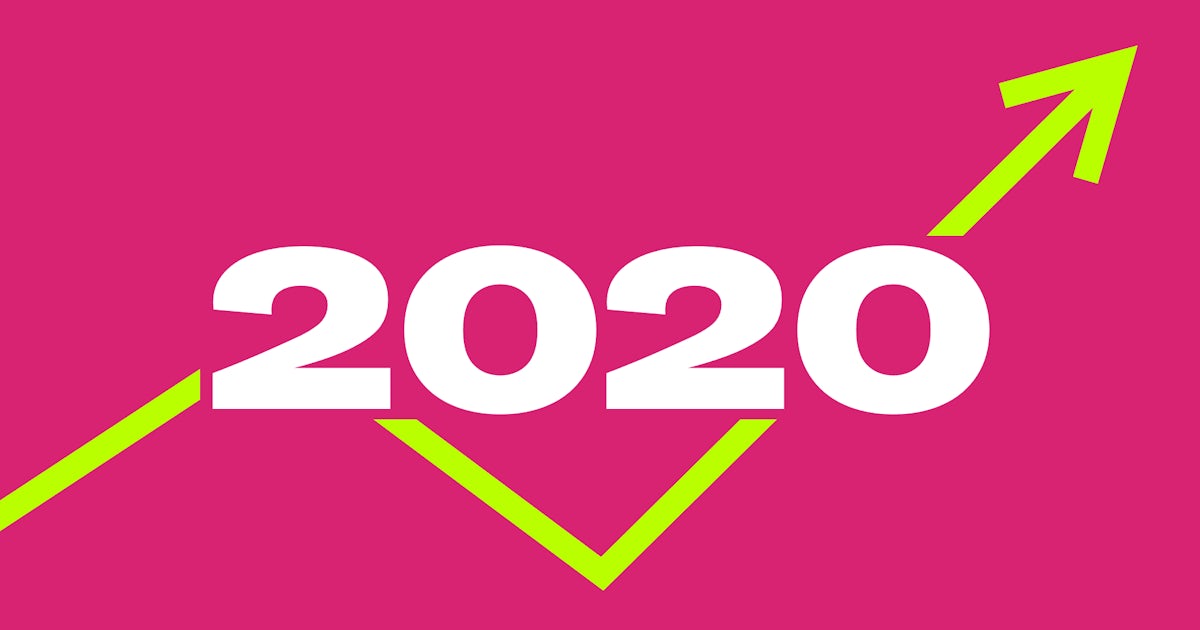
10 Trends in Digital Marketing in 2020
What’s your go-to for trends in the industry?
from Trends in Digital Marketing

Everyone knows—or should know— that the role of good marketing is to sell you a state of mind or a transformation, rather than a product or service itself.
And what is one of the most desirable states of mind for many people right now?
Escape.
But the drive-through piña coladas have run out and we’ve all been caught in the rain for a really really long time. And all the ads about tropical vacations just hit a little differently when we aren’t supposed to be traveling.
So some marketers are taking a different approach to building an escape this summer by looking ahead to the holiday season.
Christmas in July ran rampant over the last month, and if we are being honest, it’s left a lot of us wishing we had jumped on board as well. Because unlike years past, using Christmas in July for a marketing play in 2020 reads less like an overplayed cliché and more like a nostalgic look back to when things felt “normal.”
Take Hallmark for example.
The Hallmark channel knows their market intimately, and they know how passionate their fans get about Hallmark Christmas movies. These movies are a comfort zone—an emotional weighted blanket for their audience. They are predictable and warm and fuzzy: all things that have been sorely lacking this year.

So, it makes complete sense for the channel to have a Christmas in July campaign to boost views and foster positive engagement with their customers.
But what about the other brands?
What does a 2 for $5 sale from Burger King have to do with escapism and fuzzy feelings?

Everything.
Look at the comments in that post.

Burger king is hitting on a pain point: it just so happens that the pain point is simply existing in the present.
That’s the trick with escapism campaigns. You need to identify what it is about the current state that is so painful to be in, and then find a good “escape” to frame your sale or content around. When it’s done right, it works unbelievably well. But you have to find the right escape.
What works so well about the Christmas in July campaigns we are seeing is that they’ve found the perfect alternative to the present.
Christmas is all about togetherness: gatherings of friends and family to celebrate the season. And in today’s climate, gathering together is not safe, and so many people are isolated or separated from their loved ones.
So even just thinking about Christmas can create an escape for many. It’s a comforting respite from the chaos of this year.
But remember, escapism campaigns aren’t about solutions. Your goal is to take your customers to a different emotional state rather than solve their actual problem.
It’s the difference between putting Christmas baked goods on sale and selling a video chat software.

The latter solves the physical problem of isolation, while the former sends the customer back to the “good times” and simply makes them feel better.
There is a place for both types of campaigns, absolutely. But it’s important to understand their differences, so you know when to use one or the other.
That choice really comes down to what you are actually selling. Providing a solution worked well for the Portal ad, because it could actually do something about the problem. Whereas the Easy Tiger ad never stood a chance to “solve the problem,” so they leaned into the escape angle.
The world’s problems feel insurmountable right now. And trying to frame your messaging around these issues is often just too broad to make an impact.
It’s why every insurance company’s ad copy about “standing together in the face of these hard times” falls flat. They aren’t solving anything, and they aren’t taking a real stand, and they aren’t giving their audience an escape. They are just reminding them about the bad things happening.
And that just doesn’t cut it.
Escapism campaigns can also be a solution to cut through the noise on the feed. Escapism inherently breaks expectations and will often look and feel different from all the other ads and posts (or they should… if your escape looks like every other post on Instagram, it’s not really much of an escape…).
For example, this regular ad for a bidet just doesn’t have the weight to carry impact when so much else is competing for attention, time, and money.

But when you put an escapism twist on it and advertise “Christmas Bundles” with the messaging of “get into the spirit,” you’ve changed your audience’s emotional state.

This ad is not only a break from everything else in their feed, i.e. stopping the scroll, it also scoops up the viewer and plops them squarely into the Christmas spirit.
All of these Christmas in July campaigns are about an emotional state change. The ads themselves—creative, copy, and all—are an escape from the bad news that surrounds them by leaning into a perfectly curated alternative.
So, when you get to creating your own escapism campaigns, remember to pick an escape that is a perfect juxtaposition to the current emotional state of your audience.
Oh, and while we are on the subject of Christmas ads, I’m here to remind you that you should probably be starting your holiday campaigns right now. You’ve got less than 6 months to come up with the perfect sale, so don’t leave it to the last minute.
The post Christmas in July: A Marketer’s Guide to Escapism Campaigns appeared first on DigitalMarketer.
Thomas Kutzman is the founder of Prevu, a modern, full-service brokerage offering 1.5% listing agent commission.
Sponsored byToptal – Toptal is a global network of top talent in business, design, and technology that enables companies to scale their teams, on demand. Toptal serves thousands of clients, including Fortune 500 companies and innovative startups, delivering expertise and world-class solutions at an unparalleled success rate. With elite freelancers in over 100 countries, Toptal connects the world’s top talent with leading companies in days, not weeks. Plus, every new engagement begins with a no-risk trial period, so clients only pay if satisfied with the work. Get started hiring with Toptal today.
HostGator – Ready to take your website to the next level? Whether you’re a first-time blogger or an experienced web pro, HostGator has all the tools you need to create a great-looking website or online store. A wide range of options includes cloud-based web hosting, reseller hosting, VPS hosting and dedicated servers. Founded in 2002, HostGator is the perfect web partner for business owners and individuals seeking hands-on support. Visit https://ift.tt/2HikPBw to see what HostGator can do for your website.
More interviews -> https://mixergy.com/moreint
Rate this interview -> https://mixergy.com/rateint

There’s no doubt email marketing is (very) effective, but choosing which of the many email marketing services to use can be just a tad overwhelming.
It seems like every company in the space claims theirs is the best email marketing software. And when you check Google for unbiased opinions, all you see are biased reviews, bought and paid for.
Want the truth?
The best email marketing tool for you will depend on your budget, needs, and a variety of other factors. What works for someone else may not work for you, and vice versa.
Of course, most articles and reviews won’t admit such a thing. They’re too busy trying to get you to click their affiliate links.
That’s why we put together this resource.
There are no affiliate links in this guide. We’re not going to tell you which tool we use here at Smart Blogger, or which ones we typically recommend to our students.
Instead, we’re just going to give you the facts, details, and tidbits you need to know so you can find the email marketing software that best fits your needs.
Ready?
In no particular order, here are our picks for the 12 best email marketing services for 2020.
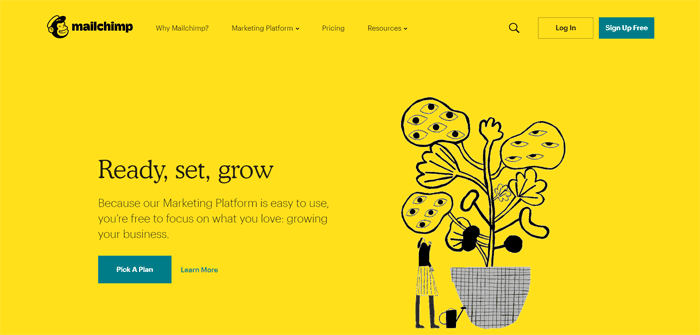
Mailchimp is one of the leading email marketing platforms, with customers in over 175 countries. Their free plan (for up to 2,000 subscribers) makes them the preferred choice of many bloggers and small business owners.
Mailchimp is easy to use for beginners and has a great drag-and-drop email builder, but also offers advanced email marketing tools like segmentation, A/B testing, autoresponders, landing pages, etc.
Mailchimp’s pricing depends on the number of subscribers. Higher plans have more robust features.
Mailchimp’s free plan is a great choice for people getting started with email marketing and those on a budget, like bloggers and small businesses. However, if you’re planning to grow your list fast and use more advanced features, make sure to look at prices beyond the free plan, because there are cheaper options.
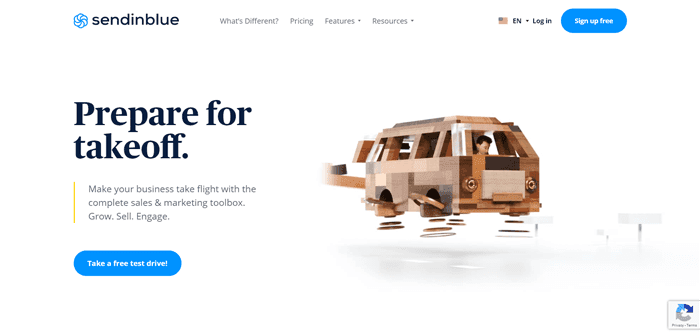
Sendinblue is an email service provider that distinguishes itself by charging per email, and not per contact.
They started specialising in transaction-based emails, but have now expanded and offer great email marketing solutions to all kinds of users, including SMS marketing and detailed email workflows.
Sendinblue has pricing based on email volume, and features depend on the plan. The number of contacts is unlimited for all plans.
Sendinblue is great for ecommerce businesses due to its variety of transactional emails. It’s also appealing to those on a budget or businesses that don’t send emails very regularly, in which case their Pay As You Go plan is a perfect solution.
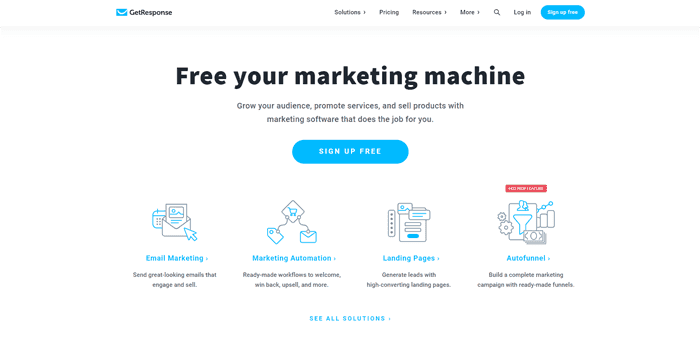
GetResponse differentiates itself from its competitors with its webinar solutions. It’s available in over 20 different languages, and besides offering all the advanced features like list segmentation, autoresponders, A/B testing and integrations, it also offers a convenient landing page editor and a modern calendar interface to visualize your drip email marketing campaigns.
The pricing depends on the plan and your list size, with more advanced features unlocking as you pay more.
GetResponse is the go-to option for businesses that want to integrate webinars into their email marketing.
Even if you’re not planning to use webinars in your online marketing strategy, GetResponse is a great fit for email-marketers that are looking for a modern interface with the latest features.
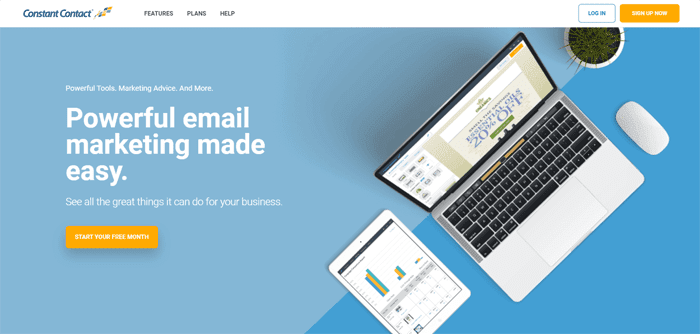
Constant Contact has been around since 1995 and is one of the most popular email marketing service providers among small business owners. What stands out are their event marketing tool and their social media integrations. You’ll also find more than 270 integrations and a decent template library that includes niche-specific email templates for you to customize.
You can choose between the Email Plan and the Email Plus Plan. Pricing is based on the size of your email list.
We recommend Constant Contact to small businesses that need event management tools, but if you don’t need that function, you may find it’s too expensive for what it offers.

Drip joined the email marketing market in 2013 and was later bought by LeadPages. They have specialized in email automations and ecommerce CRM. Their advanced automation features allow you to personalize your emails and other interactions with your clients to a high degree and you practically follow them the whole way from first visit to social media to suggestions based on past purchases, etc.
Prices are based on subscribers. Each tier offers unlimited emails.
Drip is great for ecommerce businesses, as it allows you to access all kinds of customer metrics and behaviors (and create workflows accordingly). If you want to use complex workflows, this may be the tool for you.
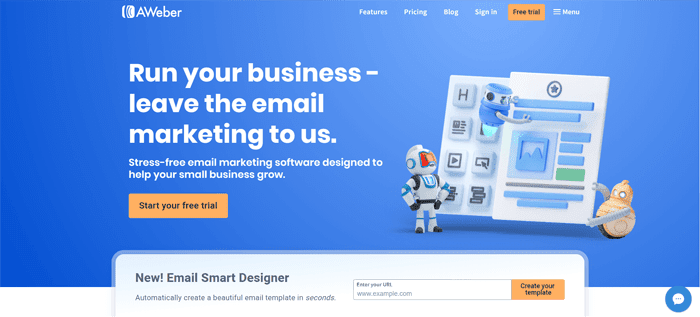
AWeber is one of the most popular email marketing services in the market, and they even claim they invented the autoresponder, which is no small feat.
AWeber has a free plan and Pro plan, with pricing determined by the number of subscribers. Each Pro plan includes all features and unlimited emails.
AWeber is a good choice if good customer service is important to you. If you want to explore the possibilities of AMP for email, AWeber is also a good choice, as few others offer it. And if you have a small email list, but want automation features, AWeber is one of the free email marketing services to offer it on a free plan.
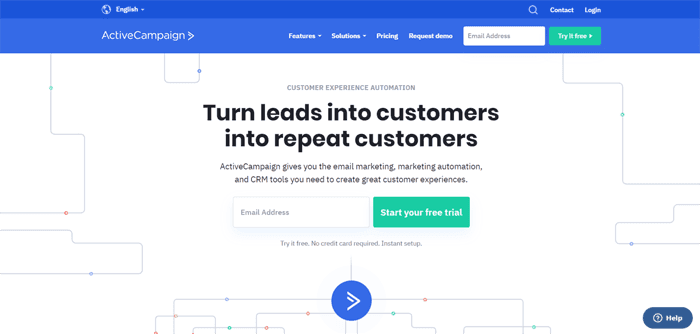
ActiveCampaign is an all-in-one marketing platform with great focus in marketing automations that use complex if/when/then logic based on your website visitor’s behavior.
As they put it, they want to help you send fewer emails while getting better results. Their CRM is a great addition to their marketing tool.
ActiveCampaign’s pricing depends on the number of subscribers and the plan you’re using. Features increase along with the plans.
If your business requires complex automation tools along with advanced CRM features, then ActiveCampaign is a good choice. And if you just want to explore the power of marketing automations to boost your sales, ActiveCampaign is a solid option.
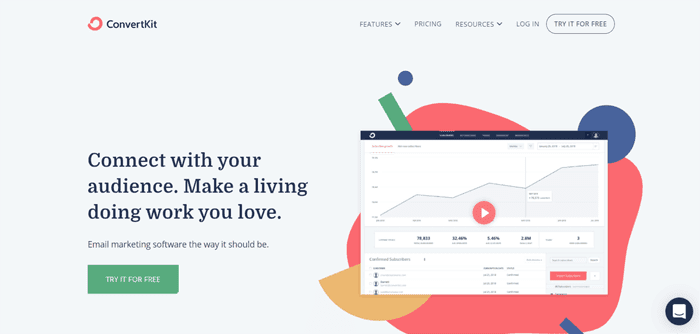
ConvertKit has been around since 2013 and mainly targets creators, meaning bloggers on WordPress, YouTubers, vloggers, online course creators, etc. They’ve focused on a simple user interface with a visual automation builder and their philosophy when it comes to emails is “keep it simple”, so they don’t offer much in terms of templates and claim that simple emails convert best.
ConvertKit’s pricing depends on the number of subscribers, but all paid plans share the same features. They also have a free plan (up to 1,000 subscribers) that has limited features.
ConvertKit is for people that don’t have complex marketing needs and want a simple email platform that will deliver what they need quickly and easily. It’s a bit pricey compared to some competitors, but if you appreciate simplicity and prefer to focus on your creative work instead, it may be what you need.
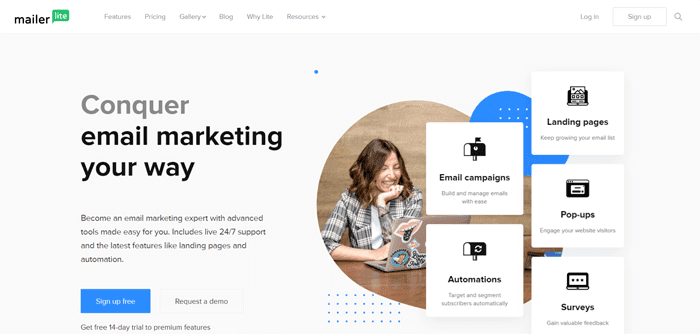
MailerLite is an email marketing platform that prides itself in the simplicity of its user interface. They are available in multiple languages and are one of the most popular providers for people on a budget. They may not have some of the advanced features of other companies, but not everybody needs that anyway, and they cater perfectly to those with simpler needs.
MailerLite charges based on your list size, but all paid plans include all features and unlimited emails. They also have a pretty generous free plan.
MailerLite is perfect for small businesses, bloggers, freelancers, and anybody else on a budget that needs a simple and affordable solution to grow their email list, but doesn’t need a marketing automation tool with advanced features that bigger companies require.
In short: if your idea of email marketing is sending out an email newsletter, with a few extras here and there, MailerLite is perfect.
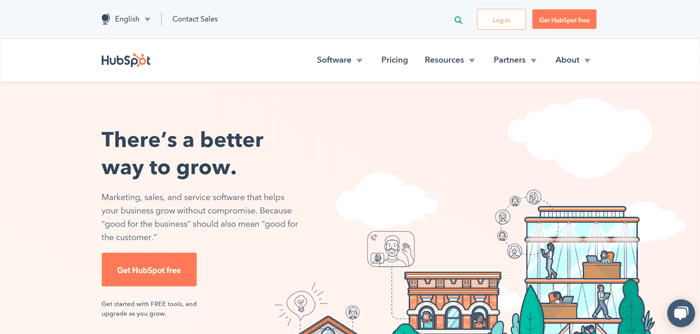
HubSpot is known for its full platform of marketing, sales, customer service, and CRM software. Their platform is very powerful, and one can get started with HubSpot with a free plan that lets you get a feel for what they have to offer.
This free plan also includes some email marketing tools, but to get a decent email marketing deal from HubSpot it will be necessary to upgrade to their paid plans.
HubSpot offers some nice marketing tools for free, but you may eventually find them limiting. If you need to upgrade, they offer paid plans in their Marketing Hub.
If you’re looking for a free solution that fits all of your needs, HubSpot is an option (but one you may quickly outgrow). If you’re looking for an all-in-one marketing platform and price isn’t an option, then HubSpot may be just what you need.
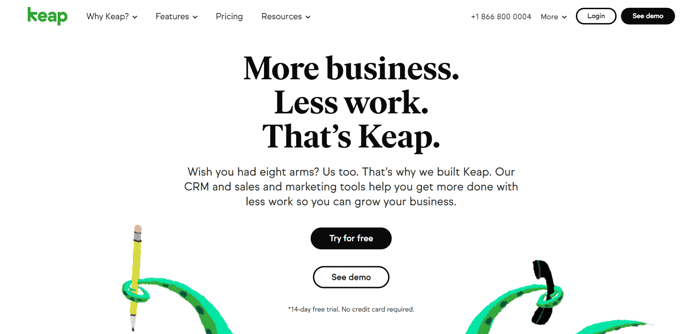
Keap (formerly known as simply Infusionsoft) is an all-in-one marketing platform that combines sales, marketing automations and CRM. Email marketing is just one of its many tools, and you can use advanced segmentation to target your leads at the right time, based on their interactions with you.
Keap offers three plans that all include 500 contacts and 1 user. To add more contacts you have to pay extra, but the extra cost is the same for all plans ($30 for 1,000, $130 for 5,000, etc).
Keap is for e-commerce and service-based businesses who are looking for an all-in-one software to manage sales, marketing automations, email campaigns, and CRM.
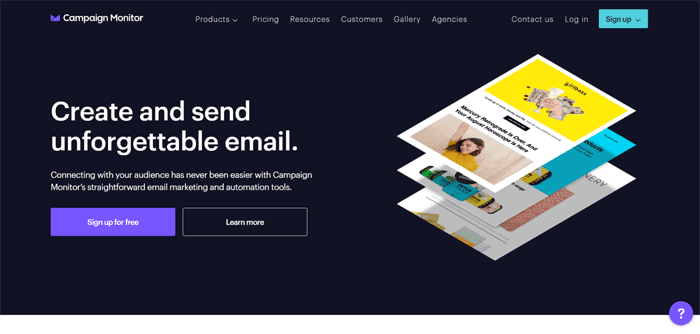
Campaign Monitor is an email marketing service that stands out for its personalization options and beautiful design. They have great-looking templates and an intuitive drag-and-drop email editor that makes creating emails a breeze. Dynamic content and segmentation allow you to tailor your emails to each individual subscriber.
The pricing depends on the plan and your list size, with more advanced features unlocking as you pay more. The Basic Plan is very simple, so you may have to consider the other two.
If you work with Salesforce, Campaign Monitor offers one of the best integrations in the market. Many appreciate their beautiful design, so if great-looking, responsive templates are important to you, make sure to check it out.
Whether you’re just starting out or you’re an email marketing pro, there are numerous email marketing services available to meet your needs.
And now, thanks to this guide, you know the highs and lows of each of them.
Which one is our favorite (and why)?
Let us know in a comment below.
The post 12 Best Email Marketing Services for 2020 (100% Unbiased) appeared first on Smart Blogger.
The post 13 Tips for Promoting Yourself Without Sounding like a Jerk appeared first on ProBlogger.

This post is based on episode 55 of the ProBlogger podcast.
So you’ve been blogging in your niche for a while now. And the more you’ve written about it, the more you’ve learned. You’re now considered somewhat of an expert in your field. And your archive backs that up, with lots of great content that can really help those looking for answers.
But how do you spread the word about your content (and your expertise) without sounding like a jerk?
This is a question I’ve been asked a lot, particularly by Australians. (I think it has a lot to do with ‘tall poppy syndrome’, where people don’t like to boast about their achievements.) And I’ve asked myself the same question a lot over the years.
So this week I’d like to offer you tips for promoting yourself without sounding like a jerk.
This may seem pretty obvious, but it needs to be said: make sure your content is worth finding. If you’re a blogger, you need to be blogging well. If you’re blogging on a specific niche, you need to understand it and have something worthwhile to say about it.
Promoting content that fails to deliver may do more harm than good. Because even if you build up a solid archive content down the track, people may never bother coming back a second time.
As I mentioned earlier, some people (particularly Australians) don’t like to boast about their achievements. And that’s exactly what self-promotion can feel like.
So don’t think of it as promoting yourself. Instead, think of it as promoting ways you can use your talent, knowledge and expertise to help other people.
My passion is helping other people improve their blogs. I’ve been blogging for quite a while now, and in that time I’ve learned a lot and developed some skills and expertise. But I can’t just sit and wait for people to come to me. I need to get myself out there, find people with questions and issues, and let them know how I can help.
And that’s what you should do too.
How often have you seen the word ‘expert’ or ‘guru’ on someone’s Twitter profile? It’s become such a cliché these days that most people either ignore the claim or laugh at it.
But when someone says they’re passionate about something you react differently. You feel compelled to read their content just so you can find out more about who they are and what they’ve done.
Passion is infectious. It stimulates conversation, which then gives you a way to talk about what you can do for people.
So start with your passions, because people will find them much more interesting. And they’ll find you much more interesting as well. There will be plenty of time to talk about your achievements later.
Another reason to avoid words like ‘expert’ and ‘guru’ is people might think you’ve stopped learning, and are no longer open to new ideas or new ways thinking.
I’m not interested in hearing from people who think they know everything there is to know about a topic. I want to hear from people who are still learning by gathering knowledge and asking questions.
And then sharing what they’ve learned with others.
So don’t be afraid to let people know you’re still learning. Share what you’ve learned. Share the things you’ve tried that haven’t worked as well as those that have. And never stop, because you will never know everything.
And that’s okay, as long as you’re honest about it.
When you get the opportunity to talk about your skills, achievements and qualifications, don’t just rattle them off as if you’re reading a list.
Tell a story.
Not only will it seem more natural, it will also put your achievements and qualifications in context. And your reader will feel a connection rather than just an admiration.
But don’t try to manipulate the conversation you’re having just so you can tell your story. Just have them ready for when the time is right.
As I mentioned earlier, a lot of people have the word ‘expert’ or ‘guru’ in their profile. And what puts a lot of people off about these claims is that it’s all open to debate. What makes someone an expert? And who decides whether someone is one or not?
But facts are much less open to interpretation. So rather than claiming to be an expert on something, talk about the number of followers you have, or the number of books you’ve written about the topic.
And then let them make up their own minds about you.
Ideally, you’d include these facts in a story rather than lead with them. But if people ask you point blank about your credentials, feel free to use the facts on their own.
The only time you should ever compare yourself to someone else is to point out why they are better than you. Don’t ever talk about how much more you know, or that your skills are better than theirs. Because you’ll be seen only as someone who puts other people down to make yourself look superior.
And that can seriously affect your reputation.
Instead, compare yourself to what you were like previously. Show them how much better you are now than when you first started.
When I talk about my blogging journey, I often mention that I had no credentials when I started out. I talk about having 20 jobs in ten years, about my average English marks at school, and how it took me three months to learn how to make text bold.
Of course, later on I’ll talk about the number of readers I’m now getting every month, and how I got to travel the world.
People like to see other people succeed. It makes them feel that they can do it too. And using these before-and-after snapshots is a great way to show you have succeeded.
But your success doesn’t need to have anyone else failing.
You’ve probably achieved some great things over the years. And while you may have accomplished a lot of these achievements on your own, there’s a good chance you had someone helping you with some of them.
And if that’s the case, you should acknowledge those who gave you that help.
In my final year of high school, I received the third-highest mark for my year level. It’s an achievement I was very proud of. But I also know it had a lot to do with being part of an amazing group of students.
That year I was in a small politics class with eight or nine other students who were amazing. We worked together, and spurred each other on. And so whenever people congratulated me on my marks I would always point out the other people in the group, and how much they helped. Yes, I worked hard. But I’m not sure I would have worked as hard if I didn’t have them supporting and encouraging me.
It’s the same with the ProBlogger events. People often compliment me for organizing and running such a great event, but most of the work is actually done by my team. So I make a point of thanking them publicly for all their hard work, and let people know who most of the credit should be going to.
This isn’t about putting yourself down. It’s about telling it like it is, and giving credit where credit is due.
I think we’ve established that no-one likes a bragger. But a lot of people don’t like excessive modesty either. Not only can it come across as false modesty, it can also make it seem like you don’t believe in yourself.
So you need to strike a balance. By all means point out your flaws. After all, no-one is perfect. But don’t be afraid to talk about your achievements and celebrate your successes.
Letting other people talk about you is often far more effective than anything you could say about yourself. People will pay far more attention to what other people say about you than what you say about yourself.
Testimonials are a great way to show what other people are saying about you. And a testimonial from the right person can give you a lot of kudos. But make sure they’re not too ‘gushy’, and don’t have too many or it may come across as boasting.
Some people attend networking events with one goal: to get their business card into the hands of as many people as possible. But I’d much rather make meaningful connections with four or five people during the event than leave with 200-odd people having only a vague idea of who I am.
Similarly, when promoting myself I try to go deep rather than wide. And I suggest you do the same.
Of course, if you find yourself speaking at a conference then going wide might work, Having a large audience hanging on your every word can be a great opportunity to spruik yourself a little. But when you have the opportunity for some one-on-one time with people, you should make the most of it. Engage with them, listen and respond to their questions, and be genuine.
And you should do the same when you’re online. Don’t just tell people about yourself in your tweets. Engage with them. You’re much better off making real connections with a few key people in your industry than having everyone know you a bit about you.
There are times when self-promotion is perfectly acceptable. Job interviews are on obvious example. If you don’t sell yourself there you’ll come across as someone who either doesn’t want the job or doesn’t believe in themselves.
But you wouldn’t want to try it at a dinner party. There you would need to show some restraint, because it’s a different type of interaction. You might be able to bring up your credentials and achievements as part of a story, but it won’t be anything like that job interview.
You also need to consider people’s cultures and even personality types. While some may find your self-promotion quite acceptable, others may not.
So how can you tell when it’s appropriate? By reading the signals and responding appropriately. If someone asks what you know, who you are, and what your experience is, by all means talk about your credentials and experience. But don’t force it on people if they don’t ask for it.
Want to know the secret to being a great influencer? It’s pretty simple. Just use what you know to help those you influence.
What’s the point in developing all those skills, and all that knowledge and expertise, if you’re not going to share what you’ve learned? Being generous and sharing your expertise will not only help others, it will also help you by growing your influence. People will quickly discover who you are, what you know and what you can do.
And shout about you from the rooftops.
This is the best self-promotion because it’s not really self-promotion. You’re simply being generous and useful to those around you. Yes, some people will take everything you have and give nothing in return. But you’ll be amazed how many people will tell other people about you, what you know, and what you can do if you’re generous to them.
So there you have it: 13 tips for promoting yourself without sounding like a jerk. And now that you know the best way to promote yourself (or not promote yourself as the case may be), I want you to give it a shot. Tell us one thing you’re going to do, and then let us know how it goes.
Photo by Ashes Sitoula on Unsplash
The post 13 Tips for Promoting Yourself Without Sounding like a Jerk appeared first on ProBlogger.